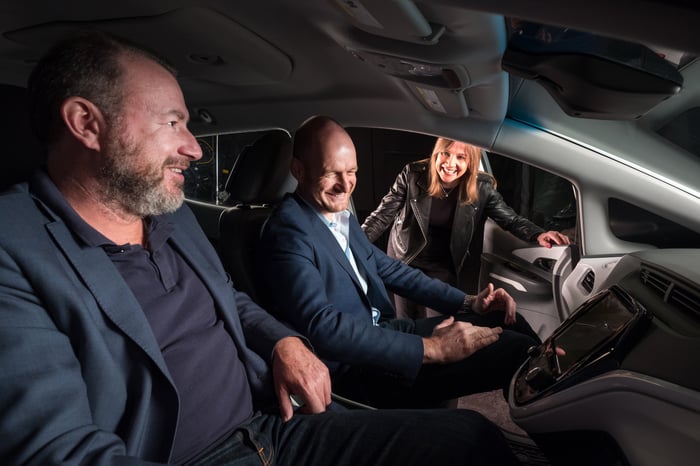General Motors (GM -0.05%) announced this morning that the SoftBank Vision Fund will invest $2.25 billion in GM Cruise, the automaker's self-driving subsidiary, as Cruise gears up to deploy self-driving taxis at scale in 2019.
This is a very big deal with implications that go far beyond the cash that the fund is investing in GM Cruise. Put another way, GM didn't do this because it needed the money -- this is about something much larger.

GM president Dan Ammann, SoftBank Investment Advisers' managing partner Michael Ronen, and GM CEO Mary Barra with a GM Cruise self-driving vehicle. A SoftBank fund will invest $2.25 billion in GM's self-driving subsidiary, GM Cruise. Image source: General Motors.
Details of GM's deal with SoftBank
First, here's the deal. The SoftBank Vision Fund is one of several venture funds run by Japanese telecom giant SoftBank Group's (SFTBF -4.43%) investment-advisory arm. The fund has agreed to invest $2.25 billion in GM Cruise in two tranches. It will put $900 million into Cruise as soon as a deal can be closed, and another $1.35 billion when Cruise's autonomous vehicles are ready for commercial deployment, likely next year.
The investment will give the fund a 19.6% stake in GM Cruise -- or put another way, the deal values GM Cruise at $11.5 billion. GM will also invest an additional $1.1 billion in GM Cruise at the closing of the first transaction with the fund.
This is explicitly a long-term investment. As part of the deal, GM and SoftBank both committed to stay invested for at least 7 years before seeking exits.
What GM Cruise gets out of this deal
At first glance, this might seem like a puzzling deal, given that GM has plenty of money in the bank: It had $17.2 billion in cash on hand as of the end of the first quarter. It didn't need SoftBank's help to fund GM Cruise.
But I think that from GM's perspective, this deal is mostly about the other things that come with an investment from SoftBank. Specifically, I think GM Cruise benefits from this deal in a couple of ways beyond the obvious impact of a big cash infusion.
First, this investment is a big, big stamp of approval from the tech world. The Vision Fund has already become a major, much-talked-about investor in important technology companies. That will be worth a lot for Cruise, which is based in San Francisco and competes with Silicon Valley players for engineering talent. It's now clear to everyone in that ecosystem that GM Cruise is far more than a legacy automaker's vanity project.
Second, SoftBank Investment Advisers actively helps its portfolio companies find ways to profitably work together, and also works to introduce its companies to new markets.
Of significance here, SoftBank has made major investments in ride-hailing. One of its other funds invested $4.58 billion in Chinese ride-hailing giant Didi Chuxing last year. In January, the Vision Fund became Uber Technologies' largest shareholder. It also owns stakes in Ola, Grab, and 99, ride-hailing firms based in India, Singapore, and Brazil, respectively.
You'll recall that GM said late last year that it expects to begin deploying autonomous vehicles in urban ride-hailing service at scale in 2019. Obviously, these companies are all potential customers for GM Cruise's autonomous taxis. It doesn't take much squinting to see where this could be going.

The GM Cruise, named for the GM subsidiary leading its development, is a self-driving battery-electric taxi based on the Chevrolet Bolt EV. GM expects to begin mass-producing it for urban ride-hailing service next year. Image source: General Motors.
It also doesn't take much squinting to see that GM might have wanted to do this deal to head off the possibility that SoftBank would do a similar deal with someone like Tesla or a Chinese automaker, or even with Alphabet's self-driving subsidiary, Waymo.
GM has said clearly that it thinks the first company to deploy self-driving vehicles at scale will have a significant advantage, and it very much wants to be that company.
What SoftBank gets out of the deal
Why did the fund choose to invest in GM Cruise rather than in other emerging autonomous-vehicle players? Michael Ronen, managing partner of SoftBank Investment Advisers, said that he sees GM Cruise as uniquely well-positioned to become a major player in autonomous vehicles.
The GM Cruise approach of a fully integrated hardware and software stack gives it a unique competitive advantage. We are very impressed by the advances made by the Cruise and GM teams, and are thrilled to help them lead a historic transformation of the automobile industry.
Just as GM Cruise gets the benefit of connections to the ride-hailing companies in SoftBank's portfolio, SoftBank gets the advantage of being able to connect those companies with GM.
It's no secret that the ride-hailing business probably requires autonomous vehicles to become profitable and sustainable over the long term. GM -- because it has both advanced self-driving software and a self-driving vehicle ready for mass-production -- is especially well-positioned to supply self-driving vehicles for ride-hailing service, soon.
What it means for GM (and Tesla) investors
Here's the takeaway for investors who own (or who have been considering) GM stock: If you didn't quite believe that GM is very well-positioned to become a major player in autonomous vehicles, it's time to start believing.
And for those investors who are still thinking that Tesla is somehow going to dominate this space, it's high time to rethink that view.





